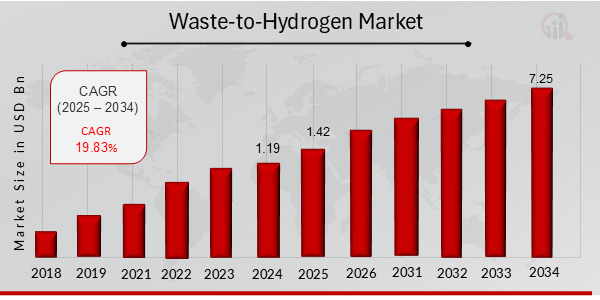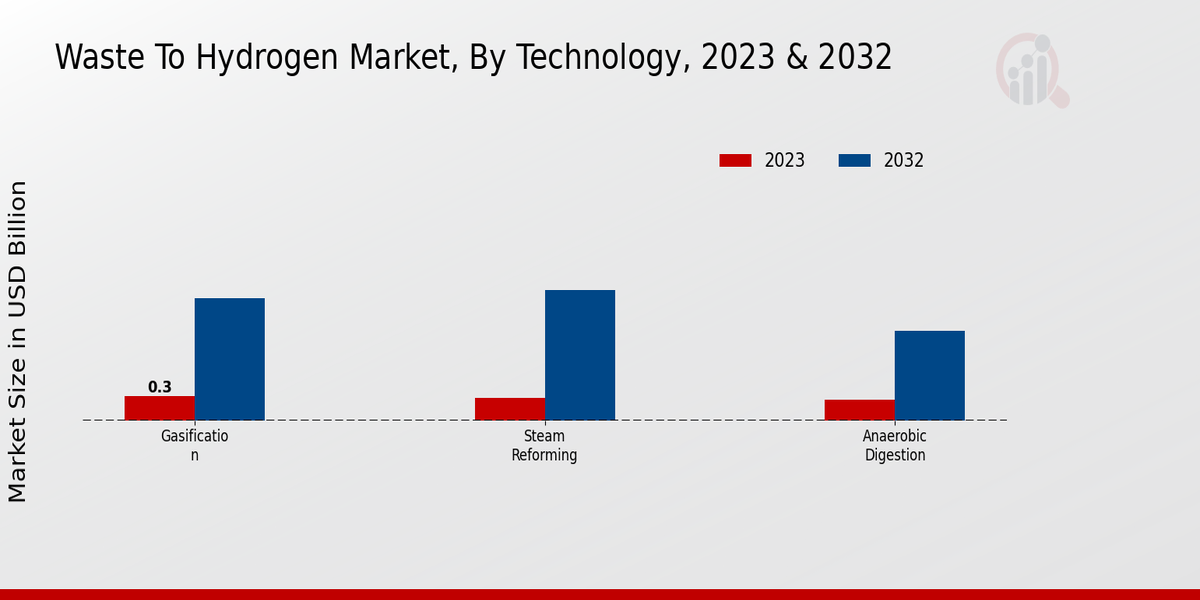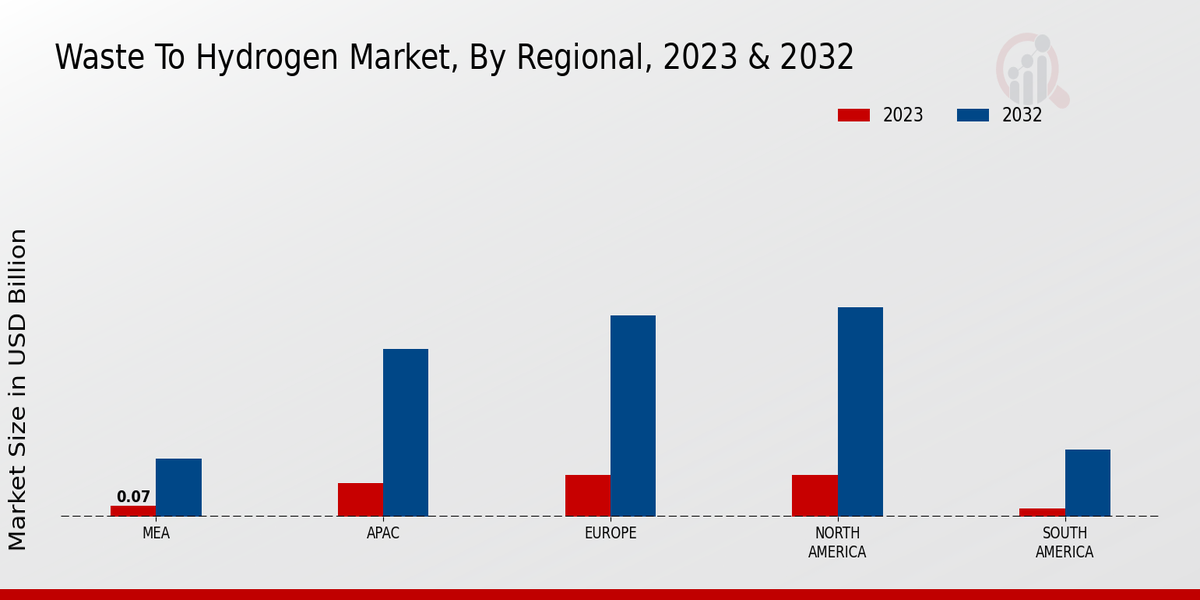Global Waste-to-Hydrogen Market Overview
As per MRFR analysis, the Waste-to-Hydrogen Market Size was estimated at 1.19 (USD Billion) in 2024. The Waste-to-Hydrogen Market Industry is expected to grow from 1.42 (USD Billion) in 2025 to 7.25 (USD Billion) till 2034, at a CAGR (growth rate) is expected to be around 19.83% during the forecast period (2025 - 2034).
Key Waste-to-Hydrogen Market Trends Highlighted
The Waste-to-Hydrogen Market is witnessing significant growth driven by an increasing emphasis on sustainable energy solutions and regulatory frameworks aimed at reducing greenhouse gas emissions. The rising awareness about the environmental impact of waste disposal and the urgent need for alternative energy sources are propelling companies to invest in technologies that convert municipal and industrial waste into hydrogen. This shift towards a circular economy not only addresses waste management challenges but also creates a clean hydrogen production route that supports various industries. Key market drivers include advancements in gasification technologies, which enhance efficiency and yield in hydrogen production from waste, alongside government incentives encouraging green energy projects.
Opportunities in the Waste-to-Hydrogen Market remain abundant as the demand for clean fuels rises alongside the transition towards low-carbon economies. Regionally, developing nations are particularly poised to leverage waste-to-hydrogen technologies due to their growing waste management issues and energy needs. Additionally, the integration of renewable energy sources in hydrogen production processes presents a unique opportunity for innovation. The increasing investment in research and development further accelerates advancements in this sector, fostering partnerships between public and private entities.
Recent trends highlight a growing collaboration between waste management companies and energy firms to develop integrated solutions that efficiently convert waste to energy, positioning hydrogen as a viable substitute for conventional fossil fuels. Furthermore, technological advancements in electrolysis and microbial processes are becoming more prominent, offering new pathways for hydrogen production from organic waste. As these dynamics evolve, the Waste-to-Hydrogen Market is set to transform, emphasizing sustainability and resource efficiency while meeting rising energy demands.

Source: Primary Research, Secondary Research, MRFR Database and Analyst Review
Waste-to-Hydrogen Market Drivers
Increasing Demand for Clean Energy Solutions
The Waste-to-Hydrogen Market Industry is experiencing a significant push due to the growing global demand for clean and sustainable energy solutions. As climate change concerns escalate, nations around the world are focusing on reducing their carbon footprints and transitioning from fossil fuels to renewable energy sources. Hydrogen, particularly when produced from waste, represents a clean energy carrier that emits only water upon utilization.
This contributes to cleaner air and a reduction in greenhouse gas emissions. Additionally, the development and implementation of favorable regulations aimed at promoting clean energy technologies further enhance the growth prospects of the Waste-to-Hydrogen Market Industry. Governments are increasingly recognizing the importance of hydrogen as a vital component in the energy transition, implementing policies and frameworks that encourage investment and innovation in hydrogen production technologies, including those that utilize waste as a feedstock.
As a result, the demand for waste-derived hydrogen is expected to surge, stimulating market growth and driving advancements in related technologies. This growing demand aligns with broader initiatives to create a circular economy where waste materials are no longer seen as liabilities but rather as valuable resources that can be transformed into usable energy. The adoption of hydrogen in sectors such as transportation, power generation, and industrial processes reinforces its potential as a mainstream energy medium, thereby solidifying the strategic importance of the Waste-to-Hydrogen Market Industry.
Technological Advancements in Production Processes
Technological advancements in hydrogen production processes are significantly pushing the growth of the Waste-to-Hydrogen Market Industry. Innovations in gasification and anaerobic digestion techniques have improved the efficiency and cost-effectiveness of converting organic waste into hydrogen. These advancements facilitate the effective extraction of hydrogen from various waste types, making the process more viable and attractive for investors and businesses.Enhanced technology reduces operational costs and increases hydrogen yield, supporting market expansion and encouraging more companies to enter the Waste-to-Hydrogen Market Industry.
Government Incentives and Support
Government incentives and support play a crucial role in driving the Waste-to-Hydrogen Market Industry. Many governments are implementing policies to promote renewable energy resources, particularly hydrogen derived from waste. These initiatives may include financial subsidies, grants for research and development, and tax benefits for companies engaged in waste-to-hydrogen projects. Such measures not only stimulate investments in the sector but also create a favorable business environment for the development and deployment of waste-to-hydrogen technologies.As regulatory frameworks become more supportive, the market for waste-derived hydrogen is set to expand significantly.
Waste-to-Hydrogen Market Segment Insights:
Waste-to-Hydrogen Market Technology Insights
The Waste-to-Hydrogen Market, focusing on the Technology segment, showcases a promising landscape with a valuation reaching 0.82 billion USD in 2023, projected to grow significantly over the coming years. The market incorporates three main technologies: Gasification, Anaerobic Digestion, and Steam Reforming, each playing a crucial role in hydrogen production from waste.
Gasification held a notable position with a market valuation of 0.3 billion USD in 2023, expected to advance to 1.5 billion USD by 2032. This technology is favored for its efficiency in converting organic and inorganic materials into syngas, making it a significant method for hydrogen generation, thus dominating this segment owing to its scalable nature and higher energy output.
In parallel, Anaerobic Digestion, valued at 0.25 billion USD in 2023, is anticipated to achieve 1.1 billion USD by 2032. This process effectively decomposes organic matter in the absence of oxygen, producing biogas that can be refined to generate hydrogen.
While Anaerobic Digestion holds a considerable share, its market capacity is comparatively lower than Gasification, reflecting its targeted application primarily in organic waste management. The importance of this technology lies in its ability to contribute to waste reduction and renewable energy generation, although its market presence indicates a niche focus in the broader hydrogen production arena.
Steam Reforming, starting at a valuation of 0.27 billion USD in 2023 and expected to grow to 1.6 billion USD by 2032, represents another significant method to produce hydrogen and is often utilized in conjunction with other technologies. This method mainly converts fossil fuels into hydrogen and is widely recognized for its cost-effectiveness and established infrastructure, making it vital as a transitional technology toward cleaner hydrogen production. The distinction in growth projections across these technologies illustrates the diversity in approaches to harnessing hydrogen from waste, each bringing unique advantages and operational contexts.
The Waste-to-Hydrogen Market is fueled by increasing environmental concerns and a strong push towards sustainable energy solutions. The market growth is driven by the desire for cleaner energy sources, regulations to manage waste effectively, and the overarching need to reduce greenhouse gas emissions. Despite promising projections, challenges remain in scaling these technologies, particularly in terms of initial investment and public awareness. However, opportunities abound, especially with ongoing advancements in technology and a growing global appetite for scalable hydrogen solutions, indicating a rich potential ahead for the Waste-to-Hydrogen Market revenue. As the market continues to evolve, segmentation will play a vital role in understanding the dynamics at play within the Waste-to-Hydrogen Market statistics and the overall industry landscape. Improved efficiency and technological innovations in Gasification, Anaerobic Digestion, and Steam Reforming will likely propel the future growth of this critical segment, aligning with global energy targets and sustainability goals.

Source: Primary Research, Secondary Research, MRFR Database and Analyst Review
Waste-to-Hydrogen Market Feedstock Source Insights
The Waste-to-Hydrogen Market is projected to achieve a valuation of 0.82 USD Billion by 2023, demonstrating a robust interest in utilizing various Feedstock Sources. This segment focuses on the conversion of different waste types into hydrogen energy, with Municipal Solid Waste, Industrial Waste, and Agricultural Residues playing pivotal roles. Municipal Solid Waste remains significant due to its accessibility and high volume generated in urban areas, contributing to sustainable energy solutions while reducing landfill impacts. Industrial Waste is also important, providing opportunities for large-scale hydrogen production given the substantial waste generated by industries, which often contains energy-rich compounds.
Additionally, Agricultural Residues leverage biomass by converting leftover crop materials into hydrogen, addressing both waste management and energy production needs. The drive for cleaner energy solutions and the reduction of greenhouse gas emissions are key growth drivers in the feedstock sector, supported by various technological advancements and investments. However, challenges such as the need for efficient processing technologies and regulatory hurdles remain evident. Nonetheless, the increasing focus on waste-to-energy projects presents substantial opportunities in the Waste-to-Hydrogen Market, underscoring its potential for growth across these diverse feedstock categories.
Waste-to-Hydrogen Market Process Type Insights
The Waste-to-Hydrogen Market has witnessed remarkable growth, with the overall market expected to be valued at 0.82 billion USD in 2023. This growth reflects the increasing demand for sustainable energy solutions and the efficient management of waste. Within this market, the Process Type segment plays a crucial role, encompassing various methodologies like Thermochemical Processes, Biological Processes, and Electrochemical Processes. Thermochemical Processes are significant as they utilize high temperatures to convert organic materials into hydrogen, offering an efficient pathway for waste conversion.
Meanwhile, Biological Processes leverage microbial actions to produce hydrogen, emphasizing the green energy potential of organic waste. Electrochemical Processes, on the other hand, are emerging as a novel approach, focusing on the electrolysis of water using different feedstocks, promising a cleaner and more sustainable hydrogen production. The interplay of these processes not only enhances the Waste-to-Hydrogen Market revenue but also highlights the importance of innovative technologies in transitioning to a hydrogen economy. As the market continues to expand, analyzing the Waste-to-Hydrogen Market statistics, data, and trends becomes essential for understanding growth opportunities and addressing challenges faced by the industry.
Waste-to-Hydrogen Market Application Insights
The Waste-to-Hydrogen Market is poised for substantial growth, particularly in its Application segment, which encompasses various critical uses of hydrogen derived from waste materials. As of 2023, the market holds a valuation of approximately 0.82 USD billion, demonstrating its expanding role in energy generation and sustainability. The Application segment includes areas such as Power Generation, Transportation Fuel, and Industrial Hydrogen Production. Power Generation is crucial, as it leverages hydrogen to produce clean energy, reflecting the global shift towards renewable sources.
Transportation Fuel is growing in significance, offering a sustainable alternative to fossil fuels, especially in hydrogen fuel cell vehicles. Additionally, Industrial Hydrogen Production plays a pivotal role, providing hydrogen for various industrial processes, including chemical manufacturing. Each of these areas showcases the versatility and importance of hydrogen in reducing carbon footprints and enhancing energy security. Overall, the Waste-to-Hydrogen Market is expected to witness increasing demand driven by the need for cleaner energy solutions and advancements in waste management technologies.
Waste-to-Hydrogen Market Regional Insights
The Waste-to-Hydrogen Market is poised for substantial growth, with a total valuation of 0.82 USD Billion in 2023, anticipated to reach 4.2 USD Billion by 2032. Within the Regional segment, North America and Europe exhibit significant investments and developments, valued at 0.25 USD Billion each in 2023, reflecting a steady commitment to sustainable energy solutions. The Asia-Pacific region holds a valuation of 0.2 USD Billion, indicating its emerging role in the market, driven by increasing industrial capabilities and urbanization.
The Middle East and Africa account for a market valuation of 0.07 USD Billion, highlighting a growing interest in hydrogen production from waste, although it remains a nascent market compared to others. South America, valued at 0.05 USD Billion in 2023, also shows potential for expansion as governments pursue alternative energy sources. Notably, Europe leads in innovation and regulatory frameworks, contributing to its dominant position in the Waste-to-Hydrogen Market. Each region faces unique challenges and opportunities, influenced by local policies and technological advancements, thereby shaping the overall market growth dynamics.

Source: Primary Research, Secondary Research, MRFR Database and Analyst Review
Waste-to-Hydrogen Market Key Players And Competitive Insights:
The Waste-to-Hydrogen Market is witnessing significant competitive dynamics driven by the increasing focus on sustainability and the urgent need for clean energy solutions. As countries and regions strive to reduce their carbon footprint and transition to green energy sources, the waste-to-hydrogen sector is gaining traction. Key players in this market are innovating, forming strategic partnerships, and leveraging advanced technologies to convert waste materials into hydrogen fuel. The growing emphasis on circular economy principles and waste management efficiency is propelling investments and encouraging the development of robust infrastructures. In this competitive landscape, companies are differentiating themselves through technological advancements, operational expertise, and a commitment to sustainability, which enhances their position in this burgeoning market.
Snam stands out in the Waste-to-Hydrogen Market due to its strong focus on integrating renewable energies and pioneering hydrogen solutions. With a well-established infrastructure supporting gas transport and storage, Snam is well-positioned to leverage its existing assets to facilitate the hydrogen supply chain. The company's expertise in managing complex energy systems enables it to innovate effectively within the waste-to-hydrogen space, promoting greater efficiency and sustainability. Snam actively engages in research and development to improve conversion technologies, positioning itself as a leader in the deployment of cleaner energy solutions.
Its collaborative approach towards partnerships with local and international entities further enhances its market presence, allowing Snam to participate in various projects aimed at harnessing waste materials for hydrogen production.ThyssenKrupp is recognized for its advanced technologies in the Waste-to-Hydrogen Market, particularly its emphasis on cutting-edge technological processes that convert Waste-to-Hydrogen efficiently. By focusing on the production of equipment and systems optimized for the conversion of waste into clean hydrogen, ThyssenKrupp showcases its commitment to innovation in this field.
The company's strong engineering capabilities allow it to develop tailored solutions that meet various project requirements, creating significant value in the hydrogen supply chain. Moreover, ThyssenKrupp's substantial investments in research and development enable it to stay ahead of market trends and continuously improve its processes. Its global footprint and collaborative ventures with municipalities and businesses position ThyssenKrupp as a competitive player in transforming waste management strategies into viable hydrogen production solutions, fostering a sustainable future in energy.
Key Companies in the Waste-to-Hydrogen Market Include:
- Snam
- ThyssenKrupp
- Waste Management
- ENGIE
- Brightmark
- Linde
- McKinsey Company
- Ballard Power Systems
- Siemens
- EnviTec Biogas
- Hydrogenics
- Plug Power
- Covanta Holding
- Air Products and Chemicals
- Toyota Tsusho
Waste-to-Hydrogen Market Industry Developments
Recent developments in the Waste-to-Hydrogen Market indicate a growing interest in sustainable energy solutions driven by environmental concerns and governmental initiatives. As more countries implement stringent regulations on waste management and carbon emissions, the conversion of waste to hydrogen is gaining traction as a viable energy alternative. Innovations in technology are progressing, particularly in gasification and pyrolysis, enhancing the efficiency of hydrogen production from waste materials.
Investments from both the private and public sectors are increasing, with several pilot projects emerging globally to demonstrate the feasibility of large-scale operations. Additionally, collaborations between startups and established energy companies are fostering advancements in this domain, leading to strategic partnerships aimed at developing infrastructure and scaling up production capabilities. The rising demand for hydrogen as a clean fuel for transportation and industrial applications further propels market growth. These trends highlight the potential of the waste-to-hydrogen sector to contribute significantly to the global energy landscape and support the transition toward cleaner energy sources.
Waste-to-Hydrogen Market Segmentation Insights
-
Waste-to-Hydrogen Market Technology Outlook
- Gasification
- Anaerobic Digestion
- Steam Reforming
-
Waste-to-Hydrogen Market Feedstock Source Outlook
- Municipal Solid Waste
- Industrial Waste
- Agricultural Residues
-
Waste-to-Hydrogen Market Process Type Outlook
- Thermochemical Processes
- Biological Processes
- Electrochemical Processes
-
Waste-to-Hydrogen Market Application Outlook
- Power Generation
- Transportation Fuel
- Industrial Hydrogen Production
-
Waste-to-Hydrogen Market Regional Outlook
- North America
- Europe
- South America
- Asia-Pacific
- Middle East and Africa
| Report Attribute/Metric |
Details |
|
Market Size 2024
|
1.19 (USD Billion)
|
|
Market Size 2025
|
1.42 (USD Billion)
|
|
Market Size 2034
|
7.25 (USD Billion)
|
|
Compound Annual Growth Rate (CAGR)
|
19.83% (2025 - 2034)
|
|
Report Coverage
|
Revenue Forecast, Competitive Landscape, Growth Factors, and Trends
|
|
Base Year
|
2024
|
|
Market Forecast Period
|
2025 - 2034
|
|
Historical Data
|
2019 - 2023
|
| Market Forecast Units |
USD Billion |
| Key Companies Profiled |
Snam, ThyssenKrupp, Waste Management, ENGIE, Brightmark, Linde, McKinsey Company, Ballard Power Systems, Siemens, EnviTec Biogas, Hydrogenics, Plug Power, Covanta Holding, Air Products and Chemicals, Toyota Tsusho |
| Segments Covered |
Technology, Feedstock Source, Process Type, Application, Regional |
| Key Market Opportunities |
1. Increasing government investments 2. Growing renewable energy demand Advancements in hydrogen production technology 3. Expansion of waste management infrastructure 4. The rising automobile fuel cell market |
| Key Market Dynamics |
increasing energy demand, governmental support and incentives, technological advancements, sustainable waste management, rising environmental concerns |
| Countries Covered |
North America, Europe, APAC, South America, MEA |
Frequently Asked Questions (FAQ) :
The Waste-to-Hydrogen Market is expected to be valued at 7.25 billion USD by 2034.
In 2024, the market size of the Waste-to-Hydrogen Market was valued at 1.19 billion USD.
The expected CAGR for the Waste-to-Hydrogen Market from 2025 to 2034 is 19.83%.
North America is expected to have the largest market value, projected at 1.25 billion USD in 2032.
The Gasification segment is projected to reach a market size of 1.5 billion USD by 2032.
The Anaerobic Digestion segment is expected to be valued at 1.1 billion USD in 2032.
Major players in the Waste-to-Hydrogen Market include Snam, ThyssenKrupp, and Waste Management.
The Steam Reforming segment is anticipated to reach a market size of 1.6 billion USD by 2032.
The MEA region is expected to grow to a market size of 0.35 billion USD by 2032.
Increased investment in sustainable technologies and rising demand for clean energy sources are key trends influencing the market.

















